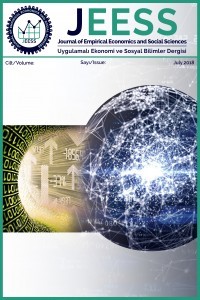DETERMINANTS OF REMITTANCES IN PAKISTAN: AN EMPIRICAL ANALYSIS OF REMITTANCES FROM SKILLED AND UNSKILLED MIGRANTS
DETERMINANTS OF REMITTANCES IN PAKISTAN: AN EMPIRICAL ANALYSIS OF REMITTANCES FROM SKILLED AND UNSKILLED MIGRANTS
Skilled migration, unskilled migration, remittances, foreign exchange., Skilled migration, unskilled migration remittances, foreign exchange.,
___
- Aydas, O. T., Ozcan, K. M., & Neyapti, B. (2005). Determinants of workers' remittances. Emerging Markets Finance and Trade , 53-69.
- Banga, R., & Sahu, P. K. (2007). Impact of remittances an poverty in developnig countries. Working Paper . World Bank.
- Bollard, A., Mckenzie, D., Morten, M., & Rapoport, H. (2009, October). Remittances and the brain drain revisited: The microdata sshow that more educated migrants remit more. Discussion Paper Series . Germnay: IZA.
- Dilshad, B. W. (2013). Impact of workers' remitances on economic growth: An empirical study of Pakistan's economy. International Journal of Businees and Management , 126-131.
- Elbadawi, I. A., & Rocha, R. d. (1992, november). Determinanats of Expariate workers' remittances in North Africa and Europe. Working Papers . The World Bank.
- Faini, R. (2006, June). Remittances and the Brain Drain. Discussion Paper Series . Germany: IZA.
- Hasan, M. M. (2008, February). The macroeconomic determinants of remittances in Bangladesh. Dhaka, Bangladesh: Institute of Microfinanace.
- Hussain, R., & Anjum, A. G. (2014). Workers' remittances and GDP growth in Pakistan. International Journal of Economics and Financial Issues , 376-381. International migrant remittances and their role in development. (2006). International Migration Outlook , 140-160.
- Javid, M., Arif, U., & Qayyum, A. (2012). impact of remittances on economic growth and poverty. Academic Research International , 433-447. Mouhoud, E. M., Oudinet, J., & Unan, E. (2008, February). Macroeconomic determinants of remittances in the southern and eastern mediteranean countries. Working Paper .
- Niimi, Y., Ozden, C., & Schiff, M. (2008, March). Remittances and the brain drain: Skilled migrants do remit less. Discussion Paper Series . Germany: IZA.
- Nishat, M., & Bilgrami, N. (1993). The detrminants of worker's remittances in Pakistan. The Paksitan Development Review , 1235-1245. Ojapinwa, & Victor, T. (2012). Determinats of migrants' remittances in Nigeria: An econometric ananlysis. International Journal of Humanities and Social Science , 295-301.
- Ponce, R. C., Preciado, V. T., & Rivera, J. L. (n.d.). Macroeconomic detrminants of remittances: The case of El Salvador .
- Ullah, I., Rahman, M. U., Jebran, K., & Zeb, A. (2015). Terrorism and workers' remittances in Pakistan. Journal of Businees Studies , 179-189.
- ISSN: 2667-7210
- Başlangıç: 2018
- Yayıncı: Burak DARICI
FACTORS INFLUENCING ON CUSTOMER CHOICE DECISION OF PROPERTY MANAGEMENT COMPANY IN BANGKOK, THAILAND
Sumas WONGSUNOPPARAT, Mareena ADAM
PANDEMİ SONRASINDA ARTAN ENFLASYON STAGFLASYONA YOL AÇABİLİR Mİ?
THE GENDER PAY GAP IN CHINA: PERSPECTIVES ON DISCRIMINATION
STAKEHOLDER IDENTIFICATION: A STUDY ON PERFOMANCE AUDIT CONCEPT AND ORGANIZATIONAL EXCELLENCE
Rachel SAHERTİAN, Dyah Ekaari Sekar JATİNİNGSİH
TİCARİ KREDİ FAİZ ORANININ BELİRLEYİCİLERİ
HOUSING CHARACTERISTICS AND MODE OF HOUSEHOLD SOLID WASTE DISPOSAL IN GHANA: AN EMPIRICAL ESTIMATION
